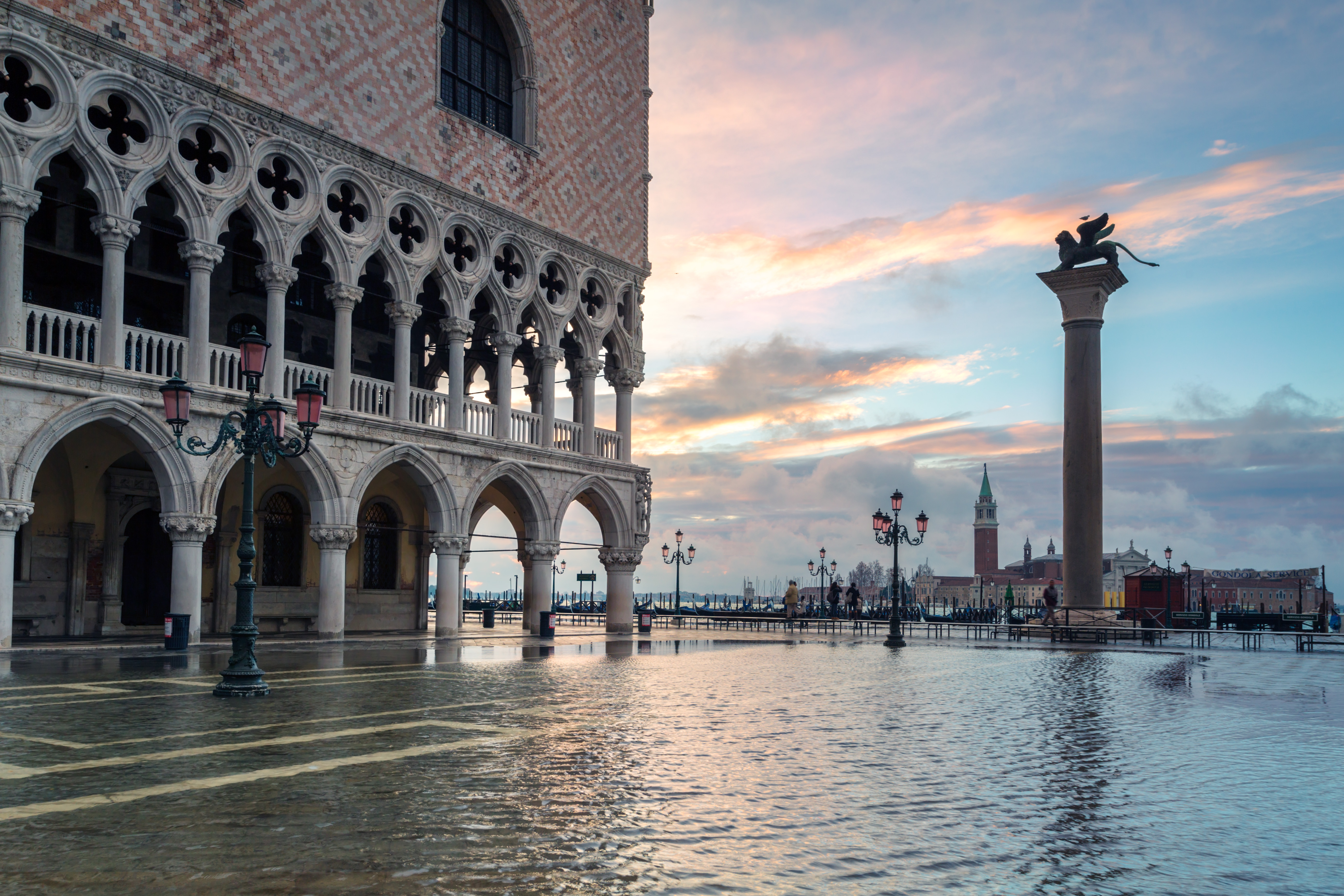历史性洪灾降临,威尼斯没有做好准备

|
安娜·帕兰德里一直穿着她的高筒雨靴,她在检查自家Paradiso Perdut餐厅的受损情况。这家餐厅位于卡纳雷吉欧社区,面朝运河,是个颇为热门的觅食去处。平日里,餐厅里会挤满大快朵颐,品味烤鱼和蛤蜊意面的当地人和来自各地的游客。 餐厅每周会举行一次现场音乐晚会,当天晚上,餐厅会清空所有餐桌,为音乐表演做好准备。餐厅网站的信息显示,包括基思·理查兹和爵士音乐家亨利·库克等知名艺术家都曾经在店内演出过。 餐厅的名字意为“失落的天堂”,但没有人真想让这里变成如其字面意思般的样子。 上周四,帕兰德里在餐厅附近徘徊时说,近期袭击威尼斯的洪水让所有人都感到措手不及。 帕兰德里是地道的威尼斯人,今年8月,她刚刚接手了这家拥有40多年历史的餐厅。她告诉《财富》杂志:“洪水我们都见过,也知道该怎么应对。洪水刚来时都比较平静,越往后水势越猛。这次开始时水势就很猛,我们以为洪水很快就会退去,但没有想到水势一直在上涨。” 洪水初起时,意大利的气象部门预测洪水水位将达到125厘米(略多于4英尺)。像许多商家一样, Paradiso Perduto餐厅也采取了各种预防措施来应对时常来袭的洪水。只要潮水水位不超过1.5米,餐厅都能安然无恙。她说:“为了安全起见,上周一晚上打烊时,我们把店内所有物品都放在了桌子上。当时我觉得就算水位上升到1.6米应该也没有问题。” 然而事与愿违。截至上周二,水位涨至53年来的最高水平:1.87米(约74英寸)。 洪水冲过防洪屏障,威尼斯的全部118个岛屿几乎都被淹没了,城市中一度有四分之三的区域被淹没在水下。用威尼斯市市长路易吉·布鲁尼亚罗的话说:“整座城市已经向洪水屈服。” 洪水至少造成两人死亡,一人死于溺水,一人死于触电。威尼斯著名的圣马可大教堂也未能幸免,洪水冲破了玻璃窗,淹没了教堂的地下室。工程师担心,长时间浸泡在洪水中或将对这座具有927年历史的拜占庭式大教堂造成结构性破坏。 许多水上巴士(威尼斯水城的水上出租车)被洪水冲上了岸,随后沉没或损坏严重。在大运河旁的地标性建筑——格瑞提酒店,洪水淹没了大堂,酒店客人不得不爬上更高的楼层躲避。 离格瑞提酒店不远处是凤凰剧院,这座著名的歌剧院多年来曾经举办过罗西尼、贝里尼和威尔第诸多音乐大师的世界首演。凤凰剧院以浴火重生的神鸟凤凰为名。在三个不同世纪中,这座著名的音乐厅曾经焚毁于三场不同的大火。在其建筑架构经受上周的洪水摧残之后,它将再次面临考验,即将到来的歌剧季或将因此无法如期举行。 今年早些时候,威尼斯宣布,自明年的旅游旺季开始,该市将对一日游的游客收取进城费,这一计划也引起了媒体的关注。让威尼斯的宫殿和桥梁相形见绌的大型游轮也成为了市政府的目标,威尼斯计划重新划定通往码头的游轮航线,借此保护脆弱的泻湖,而新线路在景色方面将会大打折扣。 但正如浪漫主义时期的诗人珀西·比希·雪莱在其诗句中写道的那样,“威尼斯的教堂与宫殿如同通向天堂的魔力织锦”,这座城市面临最大的挑战还是来自日益频繁的极端天气。 为了保护城市,威尼斯制定了“摩西”计划,该计划以圣经人物摩西(Mose)为名,MOSE也是“实验性机电模组”的意大利文缩写。该计划预计耗资80亿美元,自1987年起草立项以来,一直饱受超支及工期延误的困扰。按照计划,这一工程将在威尼斯泻湖的三个入口处修建一组闸门网,当海水上涨至一定高度,闸门便会升起,阻挡海水进入泻湖。理论上说,该计划能够保护威尼斯免遭水位在300厘米(约10英尺)以下的洪水侵袭。该项目原计划于2022年投入运行,但政治领导人在上周表示应当加速推进项目进程。 米兰工业大学的环境与土地规划教授朱塞佩·帕索尼在接受《财富》杂志采访时称,“摩西计划”是拯救这座标志性城市“最后也是最好的机会”。但是环保组织担心,“摩西计划”会让威尼斯泻湖变成一潭死水,影响栖息在此的鱼类和鸟类的生存。 与此同时,像Paradiso Perduto餐厅老板帕兰德里这样的小业主则需要解决迫在眉睫的问题。她的餐厅主要提供简单的传统美食。店里提供的意面是自己做的,酒水也是从酒桶中直接取出提供给顾客,甚至连酒单都没有。截至上周四,厨房里的设备依然是湿漉漉的,无法通电使用。 帕兰德里估计,如果像冰箱、煎锅这样的主要设备出现损坏,那么她的损失可能将超过15,000美元。但无法营业带来的损失可能更大。 她说:“我们赚不到钱还要付房租。”当被问及有没有什么事情让她充满希望,帕兰德里想了想,然后回答道:“有的,我们的面条机和烤箱放的很高,至少它们还能够正常使用。”(财富中文网) 译者:冯丰 审校:夏林 |
Anna Palandri was still wearing her rubber, knee-high fishing boots as she surveyed the damage to her restaurant, Paradiso Perduto. The restaurant is a vibrant canal-facing hotspot in the Cannareggio neighborhood where, on normal days, locals and tourists cram side-by-side to eat princely meals of grilled fish and spaghetti alle vongole. One night a week, they clear out the tables for live music. Among the bigger names that have jammed there, according to the website, are Keith Richards and the jazz musician Henry Cook. The name of the restaurant, which translates to “Paradise Lost,” was never meant to be taken literally. Sloshing around the place on last Thursday, Palandri said the floods that had battered Italy’s famed canal city in recent days caught everyone off guard. “We’ve all been through many floods, and we know what to do,” Palandri, a native of Venice who took over the 40-year-old restaurant only in August, told Fortune. “At the start, flood waters are always calmer and then it gets rougher near the end. This time around, it started rough and so we thought it was nearly done. But the water kept rising.” When the flooding began, the Italian weather service estimated it would reach 125 centimeters (a little over four feet). Paradiso Perduto, like many Venice businesses, has installed all kinds of precautions to withstand the flood waters that harass the city from time to time. Paradiso Perduto is safe as long as the surge is under 150 centimeters. “When we closed last Monday night, we put everything on table tops just to be safe,” she said. “I figured we’d be okay even if it rose to 160 centimeters.” Things turned out much differently. By last Tuesday, the water rose to its highest level in 53 years: to 1.87 meters (around 74 inches). Water burst through flood protection barriers, submerging almost all of Venice’s 118 islands. In the end, three-quarters of the city was underwater at one point, bringing, in the words of mayor Luigi Brugnaro, “the city to its knees.” At least two people died in the flooding, one from drowning and one from electrocution. In St. Mark’s Basilica, the famed church’s floors were flooded. Water pressure broke through heavy glass barriers, flooding the church’s crypt. Engineers are worried prolonged exposure to flood water could put the structure of the 927-year-old Byzantine-style cathedral at risk. Many vaporetti (the water taxis used to get around the lagoon city) either sunk or were severely damaged after washing up onto land. At the landmark Gritti Palace hotel, along the Grand Canal, a waterfall inundated the lobby, forcing guests to rush for higher floors. A short walk away from the Gritti Palace is La Fenice, the famous opera house that’s hosted world premieres from maestros including Rossini, Bellini, and Verdi over the years. It was named for the mythic bird—the phoenix—that rose from the ashes. Three different fires devastated the famous concert hall in three different centuries. It will be put to the test again after flood waters threatened the grand structure last week, possibly putting the upcoming opera season in doubt. Earlier this year, Venice earned headlines when it unveiled a plan to charge day-trippers an entry fee, starting with the high tourist season next year. The city is also looking to protect its fragile lagoon by rerouting the massive cruise ships that dwarf the city’s palaces and bridges, to plot an alternative, far less scenic route to the docks. But the biggest challenge for the city, which the Romantic-era poet Percy Bysshe Shelley described as being “like fabrics of enchantment piled to heaven,” comes from the increasingly frequent extreme weather. There is a plan to protect the city. It’s called “Mose,” which is the Italian name for the biblical figure Moses, as well as an Italian acronym for “Experimental Electromechanical Module.” Mose—an $8 billion project that has suffered through delays and cost overruns since it was first drawn up in 1987—will use a network of submerged gates that will rise up to block off the lagoon at three key junctures. In theory, it should protect the city from floods of up to 300 centimeters, or roughly ten feet. It is expected to come online in 2022, though political leaders have said last week that should be moved forward. In an interview with Fortune, Giuseppe Passoni, a professor of environmental and land planning at the Polytechnical University of Milan, called Mose the “last, best chance” to save the iconic city. But environmental groups worry Mose will suffocate the Venice lagoon, killing off fish and bird species that live there. Meanwhile, small business owners like Paradiso Perduto’s Palandri are focused on more immediate problems. When open, her restaurant focuses on simple, traditional meals. They make their own pasta and don’t even have a wine list. Instead, they serve patrons from barrels. At last Thursday, her kitchen equipment was still too wet to plug into electric outlets. If major pieces of equipment like refrigerators and her fryer don’t work, she estimates costs could surpass $15,000. But remaining closed to customers could prove to be an even bigger blow. “We aren’t earning any money, but we still have to pay rent,” she said. Asked if there was anything that made her hopeful, Palandri thought for a moment and then responded: “Yes. Our pasta machine and oven were high up. At least I know they survived.” |













